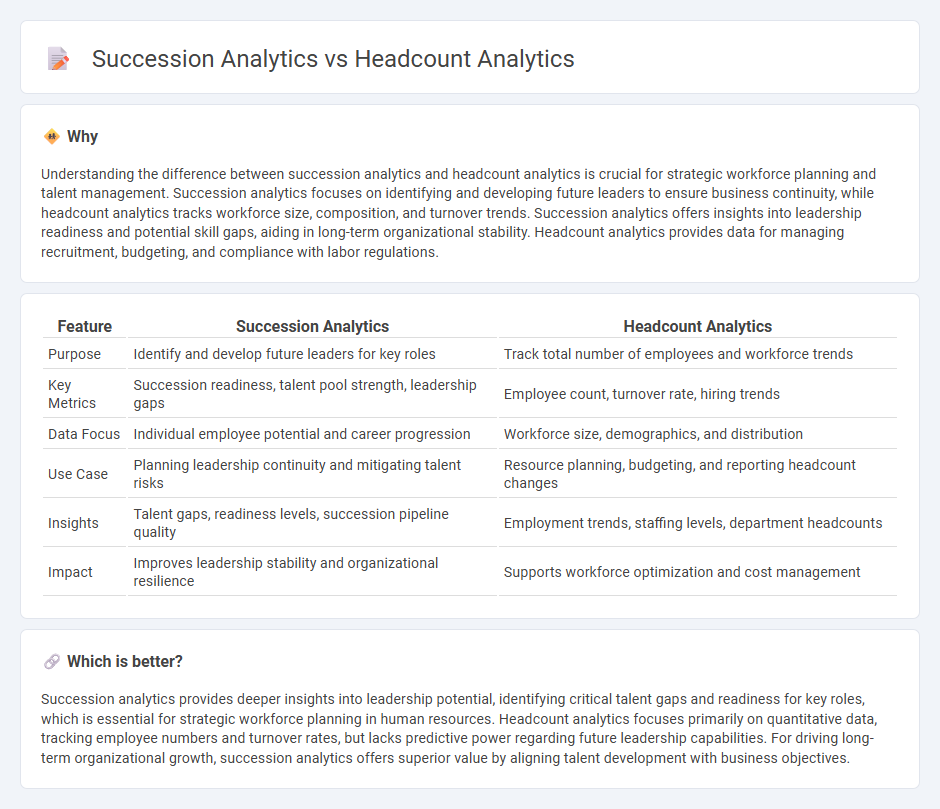
Succession analytics focuses on identifying and developing future leaders to ensure business continuity, while headcount analytics examines workforce size and composition for operational efficiency. Both approaches leverage data-driven insights to optimize talent management and organizational planning. Discover how integrating these analytics can transform strategic human resource decisions.
Why it is important
Understanding the difference between succession analytics and headcount analytics is crucial for strategic workforce planning and talent management. Succession analytics focuses on identifying and developing future leaders to ensure business continuity, while headcount analytics tracks workforce size, composition, and turnover trends. Succession analytics offers insights into leadership readiness and potential skill gaps, aiding in long-term organizational stability. Headcount analytics provides data for managing recruitment, budgeting, and compliance with labor regulations.
Comparison Table
| Feature | Succession Analytics | Headcount Analytics |
|---|---|---|
| Purpose | Identify and develop future leaders for key roles | Track total number of employees and workforce trends |
| Key Metrics | Succession readiness, talent pool strength, leadership gaps | Employee count, turnover rate, hiring trends |
| Data Focus | Individual employee potential and career progression | Workforce size, demographics, and distribution |
| Use Case | Planning leadership continuity and mitigating talent risks | Resource planning, budgeting, and reporting headcount changes |
| Insights | Talent gaps, readiness levels, succession pipeline quality | Employment trends, staffing levels, department headcounts |
| Impact | Improves leadership stability and organizational resilience | Supports workforce optimization and cost management |
Which is better?
Succession analytics provides deeper insights into leadership potential, identifying critical talent gaps and readiness for key roles, which is essential for strategic workforce planning in human resources. Headcount analytics focuses primarily on quantitative data, tracking employee numbers and turnover rates, but lacks predictive power regarding future leadership capabilities. For driving long-term organizational growth, succession analytics offers superior value by aligning talent development with business objectives.
Connection
Succession analytics and headcount analytics are connected through their joint focus on workforce planning and talent management. Succession analytics leverages headcount data to identify skills gaps and forecast leadership needs, ensuring a seamless transition in key roles. By analyzing headcount trends, organizations optimize talent pipelines and align future staffing requirements with strategic business goals.
Key Terms
Headcount Analytics:
Headcount analytics involves tracking and analyzing employee numbers, turnover rates, and workforce demographics to optimize organizational staffing and reduce labor costs. It leverages data on headcount trends, hiring patterns, and attrition to forecast staffing needs and enhance talent management strategies. Explore in-depth insights and techniques in headcount analytics to drive better workforce planning and operational efficiency.
Workforce Size
Headcount analytics provides precise data on workforce size, enabling organizations to monitor employee counts, turnover rates, and staffing trends for optimized resource allocation. Succession analytics goes deeper by identifying key roles and potential leadership gaps, ensuring a strategic approach to maintaining critical talent pipelines within the workforce. Discover how combining these analytics enhances workforce planning and supports sustainable organizational growth.
Turnover Rate
Turnover rate is a critical metric in headcount analytics, emphasizing employee retention patterns, workforce size fluctuations, and the reasons behind exits. Succession analytics leverages turnover data to identify potential leadership gaps, forecast talent needs, and develop targeted retention strategies for key roles. Explore how integrating turnover rate insights can optimize your workforce planning and succession frameworks.
Source and External Links
Headcount Analytics Dataset - Provides extensive insights into a company's workforce composition and trends for over 4.5 million entities globally.
Headcount Analysis - Offers tools and strategies for conducting robust headcount analysis that supports strategic HR management and workforce planning.
Headcount Reporting Dashboard - Emphasizes the importance of headcount analysis for financial management, strategic workforce planning, and budgeting in organizations.
 dowidth.com
dowidth.com